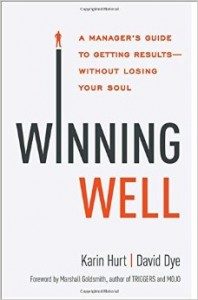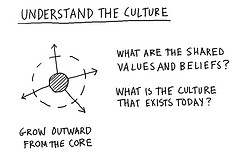|
|
|
Monday, April 25th, 2016
It’s amazing to me, but looking back over the last decade of writing I find posts that still impress, with information that is as useful now as when it was written. Golden Oldies is a collection of what I consider some of the best posts during that time.
Last Monday we looked at both an oldie and current info showing that all generations want pretty much the same things from work. What has changed is the patience factor in getting some of them. There’s also no question that the the intangibles need to be part of the culture and embedded deeply in the company’s DNA. The one thing I would add to Read other Golden Oldies here.
 A Hollister poll of 1000 people, employed and unemployed, in Massachusetts last summer asked them what factors contributed the most to their job satisfaction; the majority of responses in order were A Hollister poll of 1000 people, employed and unemployed, in Massachusetts last summer asked them what factors contributed the most to their job satisfaction; the majority of responses in order were
- Company Culture;
- Opportunities for Growth;
- Employee Appreciation;
- Work/Life Balance;
- A good Benefits Package; and
- Competitive salary/pay.
Notice that pay is dead last.
As I’ve always said, “The person who joins for money will leave for more money.”
The interesting thing about this is that numbers two through four are all parts of number one, good culture. Even benefits are a function of the culture, since they reflect the company’s attitude towards its people.
Still more interesting is that the top three are totally free—they cost the company no money—rather, they are a reflection of the corporate and/or manager’s MAP. Even number four is more about management attitude than dollars and any dollars that are spent typically offer substantial ROI.
There are tons of words that you’ll hear are important in creating a good culture, but I believe that it’s a function of two basics, one a belief and the other an action resulting from it.
Belief: People are intelligent, motivated, and they genuinely want to support their company in achieving its objectives. When people know more about their job, company, industry, and how they interact, they perform their own duties better and more productively because they understand the objectives and care about the results.
Action: People are most productive when they have all the information needed to do their job efficiently. This means that all managers, from CEO down, have both the ability and willingness to produce appropriately clear communications as to where the company is going, how it’s going to get there, what’s expected of them and how it all fits together and then disburse it accurately and completely so people can do their work in a timely manner.
If you believe that
- a key ingredient for success is a culture that recognizes employees as its most valuable (and least replaceable) asset and
- that people are required to act with initiative and their performance is directly impacted by the quality and quantity of the information they receive
- then you’ll understand that people seriously resent communication failures that cause them to perform unnecessary, incorrect or wasted work.
Technically, communications is an IBB (infrastructure building block) and we’ll be talking more about them later.
If I was writing this today the one thing I would add is a sense of mission; a belief, based in reality, that what they are doing has a great purpose/meaning than just generating revenue.
Flickr image credit: zedbee
Posted in Culture, Golden Oldies | No Comments »
Tuesday, April 19th, 2016
 A couple of years ago, in a post citing Robert Sutton’s comments on scaling, I said, A couple of years ago, in a post citing Robert Sutton’s comments on scaling, I said,
A company isn’t an entity at all. It’s a group of people all moving in the same direction, united in a shared vision and their efforts to reach a common goal. (…)Yes, it’s the people. It has always been the people all the way back to our hunter ancestors.
And it will always be the people.
Years before that I wrote about creating a Good Culture in a Toxic Environment.
My e-buddy Wally Bock says bosses need to have a duel focus to be truly successful.
One is to accomplish the mission, make your numbers in business. The other is to care for your people, keep them safe and help them grow.
To that end, I thought I’d share Wally’s review of a book offering guidance on carrying them out.
 Book Review: Winning Well Book Review: Winning Well
Several years ago at a party, I was approached by a young man who had just assumed his first management job. His name was Carl and he had a simple question: “Is there any company I can go to where I don’t have to choose between getting good results and treating people right?”
I answered Carl’s question with one of my own: “Why not stay where you are and do the job right?” I told him what I learned in the Marines, that you really have two jobs. One is to accomplish the mission, make your numbers in business. The other is to care for your people, keep them safe and help them grow.
It can be done. There are managers all over the world doing it every day. Carl and I talked some more. I tried to give him the basics of doing it right. If we were having that conversation today, I’d suggest that Carl read Winning Well.
An Overview of Winning Well
The promise of the book is in the full title: Winning Well: A Manager’s Guide to Getting Results–Without Losing Your Soul. Karin Hurt and David Dye have written a book that goes way beyond my discussion with Carl. Here’s the premise of the book, taken from chapter one.
“Winning Well means that you sustain excellent performance over time, because you refuse to succumb to harsh, stress-inducing shortcuts that temporarily scare people into ‘performing.’ You need energized, motivated people all working together. Your strategy is only as strong as the ability of your people to execute at the front line, and if they’re too scared or tired to think, they won’t. You can have all the great plans, six sigma quality programs, and brilliant competitive positioning in the universe, but if the human beings doing the real work lack the competence, confidence, and creativity to pull it off, you’re finished.”
The book is divided into four sections. The first covers the basics of Winning Well. Section two is about accomplishing the mission, getting the job done. Section three is about caring for the people, covering how you “Motivate, Energize, and Inspire Your Team.” The fourth and final section is practical advice for getting started, even if your boss doesn’t care about your soul or your team doesn’t care about the work or each other.
Who Should Not Read Winning Well
There are people who believe that all of this caring for the people stuff is nonsense. If that’s you, don’t even bother to pick up Winning Well. Wait until you think there might be something to the caring part of being a manager, then, when you’re looking for the “how to do it” part, buy the book and read it.
Who Should Read Winning Well
You should read Winning Well if you want practical advice for the real problems of getting results without losing your soul. Here are three kinds of people who can benefit from this book.
If you’re a working manager
If you’re a working manager and you want to learn the how’s of Winning Well, you can use this book in two ways. Read it straight through, making notes as you go. Then create an action plan for becoming the manager you want to be. There’s plenty of help in the book and online.
You can also read individual chapters to help you with a thorny issue at work. Dip into the book, get some just-in-time learning, and meet the specific challenge you’re facing today.
If you are a leader of managers
You’ll get a lot from this book and it’s also a great book to share with your managers. Winning Well is about rich, long term success. This would be a great book to stimulate discussion at team meetings or for a book club.
If you think you might want to be a manager
If you’re considering becoming a manager, Winning Well can help you in two ways. You’ll learn how you can be the kind of boss who gets results and builds relationships. As a bonus, the many stories and examples will give you insight into what a manager’s job is all about.
Bottom Line
If you’re a manager who wants to get great results and still have a good relationship with your people, or if you want to become that kind of manager, Winning Well will give you the insight, information, and inspiration to achieve those goals.
You can find out more about this book and how it got written by reading The Story of Winning Well on my writing site.
Post and image credit: Wally Bock; Duck image credit: gorfor
Posted in Culture, Ducks In A Row | No Comments »
Wednesday, March 23rd, 2016
 The following points are from a profile of Marvin Ellison, CEO of JC Penney and author of its successful turnaround strategy. The following points are from a profile of Marvin Ellison, CEO of JC Penney and author of its successful turnaround strategy.
He is also the guy credited with Home Depot’s turnaround after Bob Nardelli’s disastrous run as CEO.
Ellison’s attitude and approach is the 180 degree opposite of Nardelli’s imperial, top down, command and control management style.
I was at Home Depot last weekend and in conversation with two employees who were solving a problem for me, which they did brilliantly.
I mentioned how different shopping there was now compared to during Nardelli’s reign. It turned out they had both worked at HD during that time and a couple of the stories they told were beyond belief.
If you think I’m exaggerating, or are too young to remember him, note that Nardelli is number 17 on Portfolio’s Worst American CEOs of All Time.
How different is Ellison?
The following four Ellison quotes clearly illustrate his approach.
Beyond explaining his leadership skill the quotes are solid cornerstones on which to build your own approach.
“I’m trying to understand the culture and customer. In retail, understanding those two things is essential.”
“…listening to people about what we need to do;”
“There will be change, but not for the sake of change.”
“There’s nothing more instructive than asking store employees for their opinions. I have no problem doing it.”
Hat tip to Wally Bock for pointing me to this article.
Image credit: BlackPast.org
Posted in Culture, Leadership, Personal Growth | No Comments »
Tuesday, October 6th, 2015

I hear a lot form bosses who want to build good culture, but are frustrated because of an excess of how-to information — much of it contradictory.
By popular request here are the only two things you need to know to build an effective culture — everything else flows from them.
First, you have to believe the basic premise.
- People are intelligent, motivated and want to help their company/boss succeed.
Second, you need to back that belief up with appropriate action.
- Provide your people with all the information needed to understand how to perform their work as correctly, completely and efficiently as possible.
Culture frames workplace relationships and, like any relationship, it’s about open communications.
Sharing information is a sign of trust and encourages people to become more involved.
When people know about their job/company/industry and how they all interact, they will perform their own duties better and more productively — because they understand what’s going on they are encouraged to take more ownership and care.
Valuing people and open communications are the bedrock of a great culture and a boss people want to work for.
Bottom line, what to do is simple.
Doing it takes discipline.
Flickr image credit: Mike M
Posted in Communication, Culture, Ducks In A Row | 1 Comment »
Friday, April 10th, 2015
A Friday series exploring Startups and the people who make them go. Read all If the Shoe Fits posts here
 Way back in 2006 I described the difference between process and bureaucracy. Way back in 2006 I described the difference between process and bureaucracy.
I was reminded of it by a phone call from “Kev” asking for assistance because they were having trouble hiring.
He said they had no trouble attracting excellent candidates who seemed excited about the product and work, but they couldn’t seem to close them.
I asked two questions,
- How would you describe your company’s culture and its core values?
- What is your hiring process?
Kev described the culture in terms of working hard, a really fun atmosphere (foosball table, bubble machine, Friday beer bust, etc.) an “awesome product” and “incredible people.”
He said whoever was available sat in on the interview along with him and everyone had a say in whether an offer was made. They didn’t have a formal process, because they were a startup, but planned to put something in place when they started to scale.
I explained to Kev that what he described wasn’t really a culture; that real culture is based on inviolate values.
Moreover, processes created outside or in ignorance of existing culture won’t work. It’s that simple.
That’s because the culture is anchored by and tied to the founder’s values and MAP.
For example, startups/high growth companies are often hotbeds of raging egos. If the culture is tolerant of that then the level of open communications that form the basis of great culture leading to good process is impossible.
Further, process created without a solid cultural basis will quickly turn to bureaucracy — which will slow growth while accelerating turnover.
For more information read If the Shoe Fits: Culture is Numero Uno
Join me next Thursday for a look at how to create a successful hiring process.
Image credit: HikingArtist
Posted in Culture, Hiring, If the Shoe Fits | No Comments »
Thursday, April 2nd, 2015

Great culture is about values, not fancy offices, free food, perks, etc., because, done well, it provides a blueprint for any worker faced with making a decision.
Great cultures don’t happen by accident or benign neglect, nor do they grow organically.
They are the result of focused thought, intentional design and, focused effort.
They are sustained through exceedingly careful hiring and the willingness to walk away from a candidate whose values aren’t compatible.
For great insight into building a values-based company read this interview with John Montgomery, founder of Bridgeway Capital Management.
The investment industry is known more for its greed than its social sensitivity, but Bridgeway has been making waves for more than 20 years by giving 50% of its profits to charity and capping top salaries.
Montgomery’s approach has been profitable, as well as a talent magnet and retention tool.
John, you founded Bridgeway Capital Management 22 years ago and your firm grew to manage billions in assets. Many people are drawn to your firm because you are values-driven, and your website says your core values are: ‘integrity, performance, efficiency, and service’. What does it mean to live these values? (…) “We’re not trying to create golden handcuffs to keep people in place. We’re trying to create an amazing place to work where people can provide investment advisory services and give back at the same time. On my team — the investment advisory team — we’ve lost one portfolio manager or researcher in 20 years.”
If a culture built around ‘integrity, performance, efficiency, and service’ can propel and sustain a company in an industry like financial services where talk is cheap and talent is supposedly focused only on what’s in it for them, think what strong values can do for your company.
Image credit: Dave Gray
Posted in Culture, Entrepreneurs | No Comments »
Wednesday, March 25th, 2015

Yesterday we looked at how a new IBM analytics tool that analyzes tweets found that customer loyalty was severely impacted by employee turnover.
A decade ago research by Frederick Reichheld found that a 5% improvement in employee retention translated to a 25%-100% gain in earnings.
Deloitte recently released its annual survey, which seems to back up the need for improved retention.
2015 Global Human Capital Trends report, their annual comprehensive study of HR, leadership, and talent challenges, the top ten talent challenges reported for 2015 are: culture and engagement, leadership, learning and development, reinventing HR, workforce on demand, performance management, HR and people analytics, simplification of work, machines as talent, and people data everywhere.
The first three are nothing new; the terms have changed over the years, although not the meaning behind them or their ranking as top concerns.
In a major employee retention push, companies are turning to algorithms and analytics to mine a raft of data, identify which employees are most likely to leave and then try to change their minds.
But some things never seem to change and until they do companies won’t make much headway.
At Credit Suisse, managers’ performance and team size turn out to be surprisingly powerful influences (emphasis added –ed.), with a spike in attrition among employees working on large teams with low-rated managers.
With decades of research saying the same thing, it makes one wonder why the finding was “surprising.”
In fact, nothing will change until companies, bosses and the media stop being surprised every time a survey shows that talent acquisition and retention is most influenced by
- the culture in which they work;
- the bosses for whom they work;
- the work itself; and
- the difference they can make.
Gee, maybe it really is rocket science.
Image credit: Steve Jurvetson
Posted in Culture, Motivation, Retention | No Comments »
Tuesday, March 24th, 2015

Back in October Twitter and IBM announced a new service to give enterprise a way to mine its 15 billion daily tweets.
Of the research done since the, one result surprised them.
The more a customer shops at a particular store or eats at a particular restaurant, the more likely they are to stop shopping there when employees leave. It stands to reason that you would get to know the people at a place you patronize often, but IBM found that really loyal customers get so attached to employees that they complain on Twitter about having to “start over” if a favorite employee leaves. If they don’t feel like employees know them, this can really impact revenue because the loyal customers are the ones who spend the most money.
Do you find that surprising? I don’t, having done the same thing myself. (I’ve also switched brands when a favorite was acquired by a company I didn’t trust.)
Cost of customer acquisition is the most critical, prime metric when valuing any business, from startup through Fortune 50.
For the last few decades the prime focus has been on investors, while customers came in a long second; IBM’s findings move customers much closer to investors.
Why employee turnover results in customer defections isn’t the least surprising.
It’s a well accepted dictum that people don’t leave companies, they leave managers — or leave because of management turnover, so customers leaving for a similar reason makes sense.
However, employees are still a long third behind investors and customers.
When I started writing this blog back in 2006 I cited research by Frederick Reichheld that proved a 5% improvement in employee retention translated to a 25%-100% gain in earnings.
You would think that a 25% earnings increase, let alone higher, would be enough to get the attention of even the greediest Wall Street types, but obviously not, since low employee turnover is still cause for amazement.
Perhaps the new Twitter/IBM findings will help drive the needed change.
Image credit: BetterWorks Breakroom
Posted in Culture, Retention | 1 Comment »
Tuesday, February 24th, 2015
I’m in love — with a man I never met, never spoke to, never followed or chatted with online.
His name is Rich Waidmann and he’s founder and CEO of Connectria Hosting.
I love him because when he started his company he consciously set out to make it a great place to work.
That means it’s a job requirement at his company that every employee treat everyone else with courtesy and respect as well as “going the extra mile” to take care of people in the community who are less fortunate
Then his company did a survey and found that
More than half (55%) of 250 IT professionals in the US. surveyed said they had been bullied by a co-worker. And 65% have said they dreaded going to work because of bad behavior of a co-worker.
Waidmann believes it shouldn’t be that way so he’s starting a No Jerks Allowed movement in an effort to encourage better cultures.
Way back in 2007 Stanford’s Bob Sutton wrote The No Asshole Rule: Building a Civilized Workplace and Surviving One That Isn’t, but looking at the stats I’m not sure how much good it actually did.
And considering the fact that companies are shoehorning more people into less space something needs to change.
The Talmud says, “We do not see the world as it is. We see the world as we are.” Moreover, it’s often as we are that particular day, or even minute, and even as we change, minute to minute, so do others.
Jerks are known to lower productivity and kill innovation, so a lot of good information on identifying and dealing with jerks has been developed since Sutton’s book came out.
Contributing to that effort, here are my four favorite MAP attitudes for dealing with jerks.
- Life happens, people react and act out, but that doesn’t mean you have to let their act in.
- Consider the source of the comment before considering the comment, then let its effect on you be in direct proportion to your respect for that source.
- Use mental imagery to defuse someone’s effect on you. This is especially useful against bullying and intimidation. Do it by having your mental image of the person be one that strips power symbols and adds amusement. (Give me a call if you want my favorite, it’s a bit rude, but has worked well for many people.)
And, finally, the one I try to keep uppermost in my mind at all times
- At least some of “them” some of the time consider me a jerk—and some of the time they are probably correct.
Image credit: Connectria
Posted in Culture, Ducks In A Row, Personal Growth | No Comments »
Friday, February 20th, 2015
A Friday series exploring startups and the people who make them go. Read all If the Shoe Fits posts here.
 If anything has changed in the 21st Century it’s the recognition that culture is everything — the true “make or break” for any company. If anything has changed in the 21st Century it’s the recognition that culture is everything — the true “make or break” for any company.
Knowing that, founders, of all people, should know better than to do anything that undermines their culture.
And yet they do it all the time.
One of the worst is also one of the commonest — having two teams
- the one to which they pay lip-service and talk about in public; and
- the one that has their ear, takes priority and stays front and center in all decisions.
Founders constantly refer to their “team” and it’s taken to mean all the company’s employees.
But, for those the shoe fits, it actually refers to their stars, their pets and all (most?) of their direct reports.
This was a common attitude in larger companies, but at least it was honest; bosses were ‘us’, workers were ‘them’ and everybody knew where they stood.
The changes started when Volvo focused the world on the power of teams, research showed that productivity increased when people were more invested and engaged in their work and terminology was introduced that is inclusive and empowering.
Fast forward to now and that language is in common use, but, as with most things, it can be distorted and perverted.
Founders, like other bosses, fall in two categories.
- Those who buy it, own it, use it and mean it;
- and those who use it to keep everyone in line who’s not on the ‘real’ team.
Which are you?
And before you claim the first bullet take a good look at your past actions.
In fact, get some feedback from someone you know will tell you the truth, as opposed to what you already “know” or want to hear.
Image credit: HikingArtist
Posted in Culture, If the Shoe Fits | No Comments »
|
 Subscribe to
Subscribe to
MAPping Company Success
About Miki 
Clarify your exec summary, website, etc.
Have a quick question or just want to chat? Feel free to write or call me at 360.335.8054
The 12 Ingredients of a Fillable Req
CheatSheet for InterviewERS
CheatSheet for InterviewEEs™
Give your mind a rest. Here are 4 quick ways to get rid of kinks, break a logjam or juice your creativity!
Creative mousing
Bubblewrap!
Animal innovation
Brain teaser
The latest disaster is here at home; donate to the East Coast recovery efforts now!
Text REDCROSS to 90999 to make a $10 donation or call 00.733.2767. $10 really really does make a difference and you'll never miss it.
And always donate what you can whenever you can
The following accept cash and in-kind donations: Doctors Without Borders, UNICEF, Red Cross, World Food Program, Save the Children
*/
?>About Miki
About KG
Clarify your exec summary, website, marketing collateral, etc.
Have a question or just want to chat @ no cost? Feel free to write
Download useful assistance now.
Entrepreneurs face difficulties that are hard for most people to imagine, let alone understand. You can find anonymous help and connections that do understand at 7 cups of tea.
Crises never end.
$10 really does make a difference and you’ll never miss it,
while $10 a month has exponential power.
Always donate what you can whenever you can.
The following accept cash and in-kind donations:
|
A Hollister poll of 1000 people, employed and unemployed, in Massachusetts last summer asked them what factors contributed the most to their job satisfaction; the majority of responses in order were




 A couple of years ago, in a post citing Robert Sutton’s comments on scaling,
A couple of years ago, in a post citing Robert Sutton’s comments on scaling,  Book Review: Winning Well
Book Review: Winning Well The following points are from a
The following points are from a 
 Way back in 2006 I described
Way back in 2006 I described 




